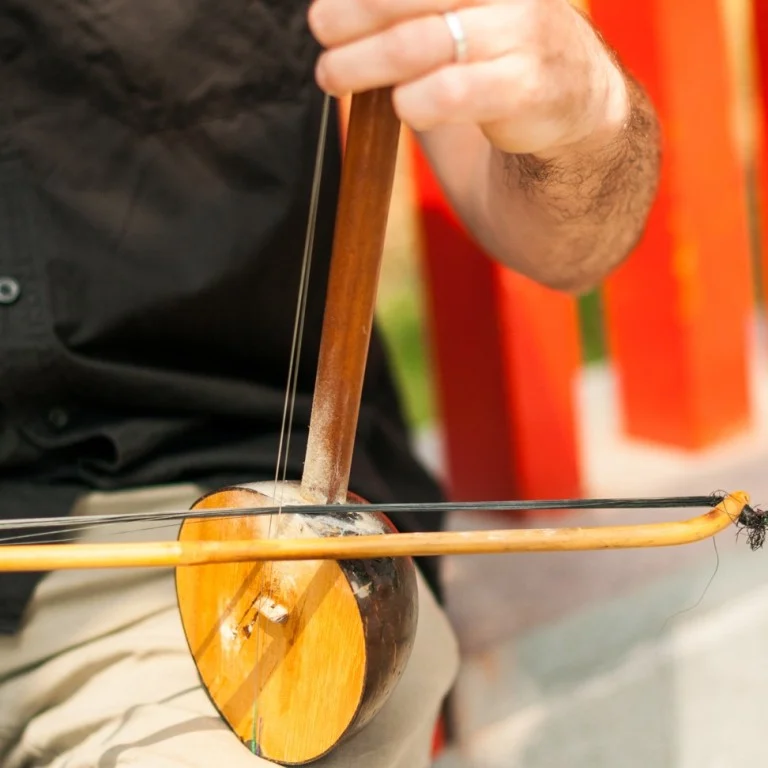Kingri
Bowed Instruments
Asia
Between 1001 and 1900 AD
Video
The kingri, a traditional one-stringed spike fiddle from India, is a fascinating instrument that has captured the attention of musicians and cultural enthusiasts alike. This unique instrument, known for its distinctive sound and construction, reflects the rich musical heritage of India.
It is characterized by its simple yet effective design. It consists of a long stick-like neck made from bamboo or wood that extends through a resonator, typically made from unglazed clay or half a coconut shell covered with animal skin. The string, traditionally made from horsehair but often replaced with metal in modern versions, is stretched over a small movable bridge. The bridge lifts the string off the surface of the resonator, allowing it to vibrate freely when played. To produce sound, the player uses a bow made of horsehair or synthetic materials. Unlike conventional string instruments that are held under the chin or between the knees, the kingri is held against the chest. The player stops the string using their fingernail rather than their fingertip, which requires a unique technique and can be quite challenging for beginners. This method of playing allows for a wide range of tonal variations and expressive capabilities. The kingri’s sound is often described as warm and resonant, capable of producing both melodic lines and rhythmic patterns. It is an instrument that thrives on improvisation, making it a favorite among folk musicians who wish to express their creativity.
History and Origin
The origins of the kingri can be traced back to central India, where it has been played for centuries. While exact dates are difficult to pinpoint, it is believed that this instrument emerged during the 16th century as part of India’s rich tradition of folk music. The kingri’s construction reflects indigenous craftsmanship and resourcefulness, utilizing locally available materials such as bamboo and clay. As a spike fiddle, the kingri shares similarities with other traditional instruments found across Asia and Africa. Its design is akin to that of instruments like the erhu from China and various spike fiddles from Africa. The kingri’s presence in India highlights the continent’s diverse musical landscape and its ability to adapt and evolve. Historically, the kingri was often associated with itinerant musicians known as “bards” or “minstrels,” who traveled from village to village performing at social gatherings, festivals, and religious ceremonies. These musicians played an essential role in preserving oral traditions and storytelling through music.
Types and Features
While primarily recognized as a one-stringed instrument, variations of the kingri exist across different regions of India. Each version may have slight differences in construction materials or playing techniques but retains the core characteristics that define this unique instrument.
Traditional Kingri: The standard one-string version made from bamboo with a clay resonator.
Modern Kingri: Incorporates metal strings for enhanced durability and sound projection.
Regional Variants: Different states in India may have their adaptations of the kingri, reflecting local musical styles and preferences.
The features of the kingri contribute to its distinctive sound quality. The combination of materials used in its construction—bamboo for flexibility and clay or coconut for resonance—creates a rich sonic palette that can evoke a wide range of emotions. The movable bridge allows players to adjust the pitch easily, further enhancing its versatility.
Music Composed with Kingri
The music composed for the kingri spans various genres within Indian folk music. Traditionally used in storytelling and ceremonial contexts, this instrument accompanies vocal performances that narrate tales of love, valor, mythology, and daily life. The melodies played on the kingri often reflect regional themes and cultural practices. In contemporary settings, musicians have begun to experiment with blending traditional kingri sounds with modern genres such as fusion music and world music. This fusion has led to innovative compositions that appeal to broader audiences while maintaining ties to traditional roots. The improvisational nature of kingri music allows musicians to explore new melodies spontaneously while drawing upon established folk traditions. This characteristic makes it an ideal instrument for collaborative performances where creativity can flourish.
Significance in Indian Culture
The significance of the kingri extends beyond its musical capabilities; it serves as an emblem of cultural identity for many communities in India. As an integral part of folk traditions, it represents resilience and adaptability in preserving cultural heritage amidst modernization.In rural areas where access to formal education may be limited, musicians often learn to play instruments like the kingri through oral tradition. This process fosters community bonds as knowledge is passed down through generations. Additionally, performances featuring the kingri often accompany social events such as weddings and festivals, reinforcing its role in communal celebrations.In recent years, efforts have been made to promote awareness about traditional instruments like the kingri through workshops and cultural festivals.
These initiatives aim to revive interest among younger generations while ensuring that this unique musical heritage continues to thrive. The kingri is not merely an instrument; it embodies centuries of cultural expression within Indian society. Its distinct sound resonates with stories from the past while adapting to contemporary musical landscapes. As we continue to celebrate diversity in music worldwide, instruments like the kingri remind us of our shared humanity through art.
FAQ
How does the Kingri work?
The Kingri is played by drawing a bow across its gut or metal strings, while the player uses finger pressure to vary the pitch. Its resonating body amplifies the sound, creating a rich, melodic tone.
What type of music is the Kingri used for?
The Kingri is commonly used in Indian folk and classical music. It is especially prominent in devotional songs, regional folk traditions, and as an accompaniment for traditional dances.
What is the cultural significance of the Kingri?
The Kingri holds cultural importance in India as a traditional string instrument. It is valued for its role in preserving folk music heritage and is often associated with rural and ceremonial music.
 Links
Links
References
Other Instrument
Categories


















